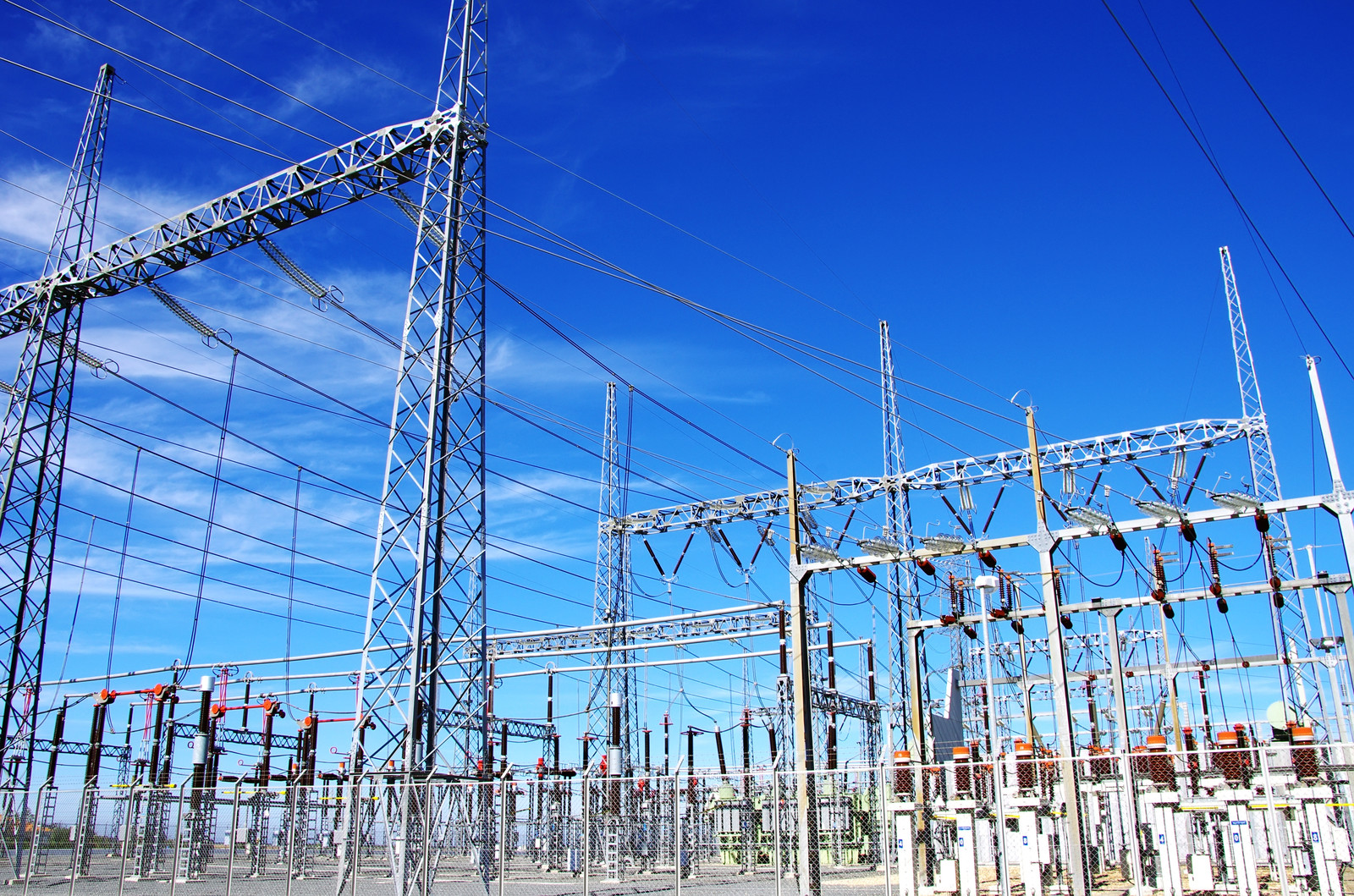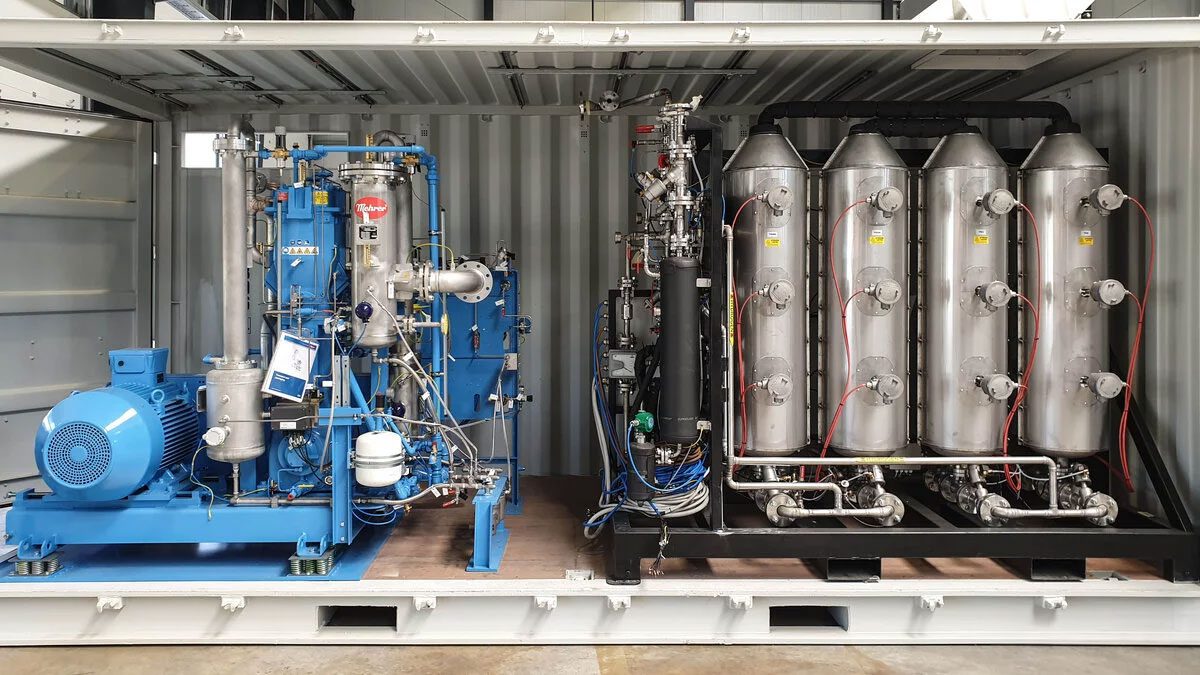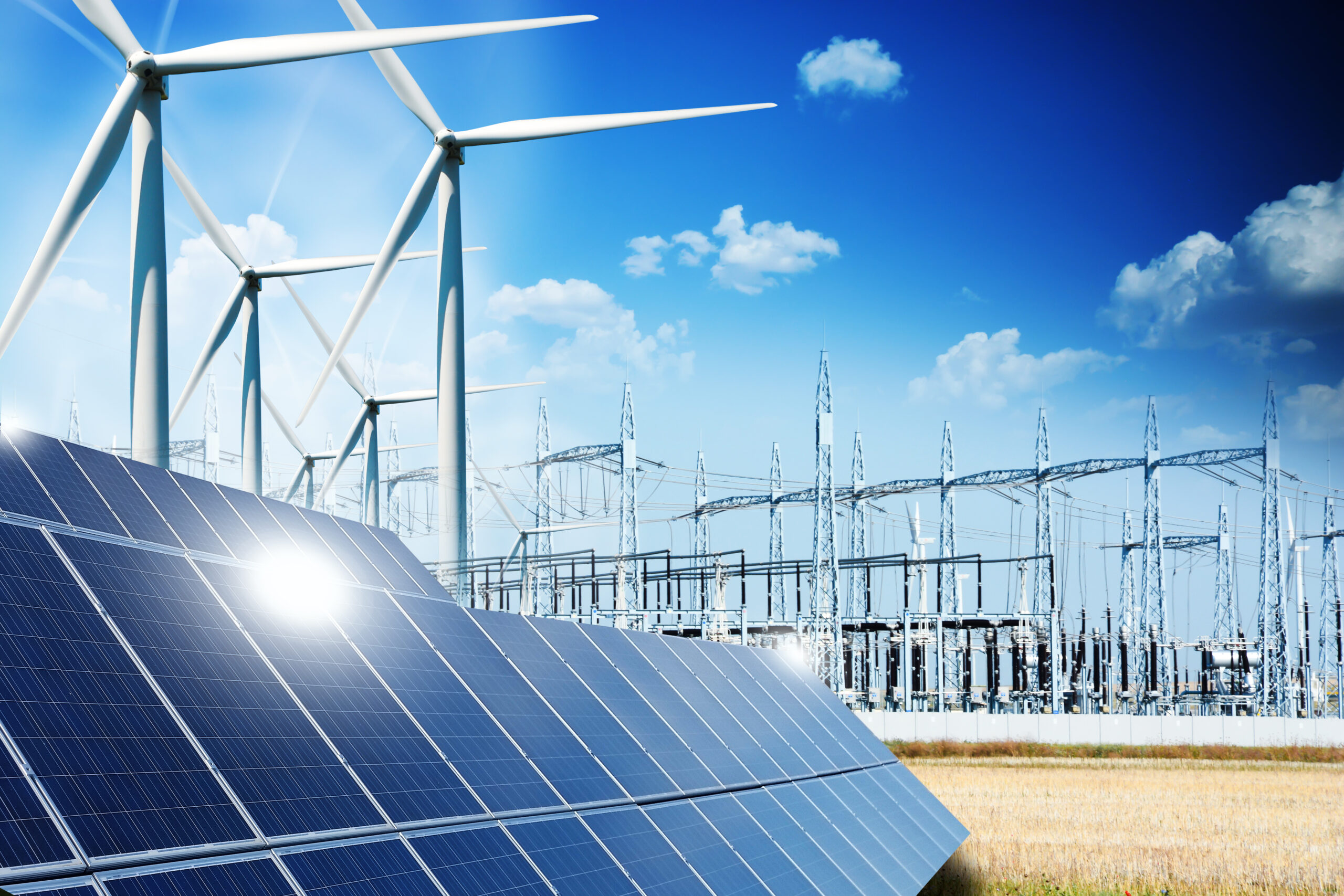(ABSTRACT) In the quest for a zero-emission future, green hydrogen has emerged as a pivotal player, driven by innovations in Europe’s research and development sector. This article explores the potential of hydrogen, particularly green hydrogen, as a sustainable energy source and its diverse applications. Highlighting a groundbreaking achievement in aviation by H2FLY, it delves into the challenges hindering large-scale hydrogen production projects. Moreover, it sheds light on the intricate regulations surrounding hydrogen handling, focusing on the Seveso III Directive, which imposes stringent duties and obligations on industry stakeholders. Through informative graphics, readers will gain a comprehensive understanding of this vital regulation as Europe paves the way towards a greener, hydrogen-powered future.
There is a consensus about Low-emission Hydrogen as one of the major elements to have into account on the proposed road to zero emissions. Specially, most actors of the industry are turning towards the Green Hydrogen which results from electrolysis using clean or renewable sources of energy such as solar or wind.
They are exploring all usages and capabilities of it to be used as storage, derivate and final fuel for diverse applications. Just a few days ago on September 2023 Stuttgart H2FLY a developer of hydrogen-electric power systems for aircrafts announced that they “successfully completed the world’s first piloted flight of an electric aircraft powered by liquid hydrogen”1 on this achievement Professor Josef Kallo, co-founder of H2FLY stated “This achievement marks a watershed moment in the use of hydrogen to power aircraft. Together with our partners, we have demonstrated the viability of liquid hydrogen to support medium and long-range emissions-free flight, … We are now looking ahead to scaling up our technology for regional aircraft and other applications, beginning the critical mission of decarbonizing commercial aviation,”2.
On research and development, Europe region is leading the path on innovation technologies on this subject, the International Patent Families (IPFs) serve as a standardized measure for assessing patenting endeavors across various categories of hydrogen-related technologies and, according to the International Energy Agency IEA on their 2023 report Hydrogen Patents for a Clean Energy Future proves this leadership.
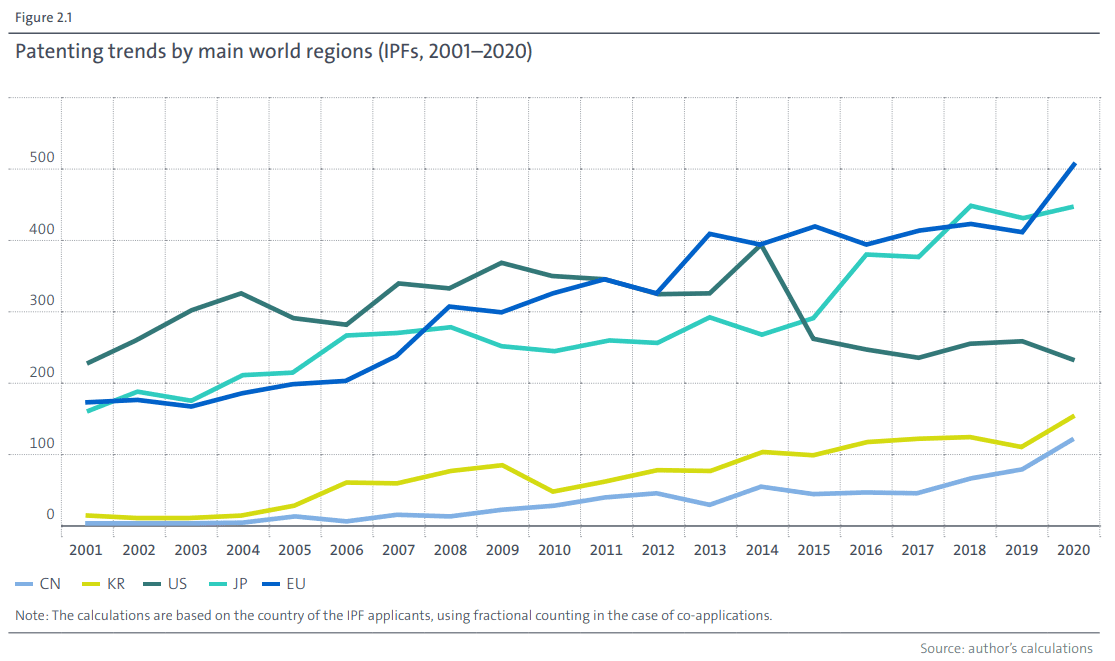
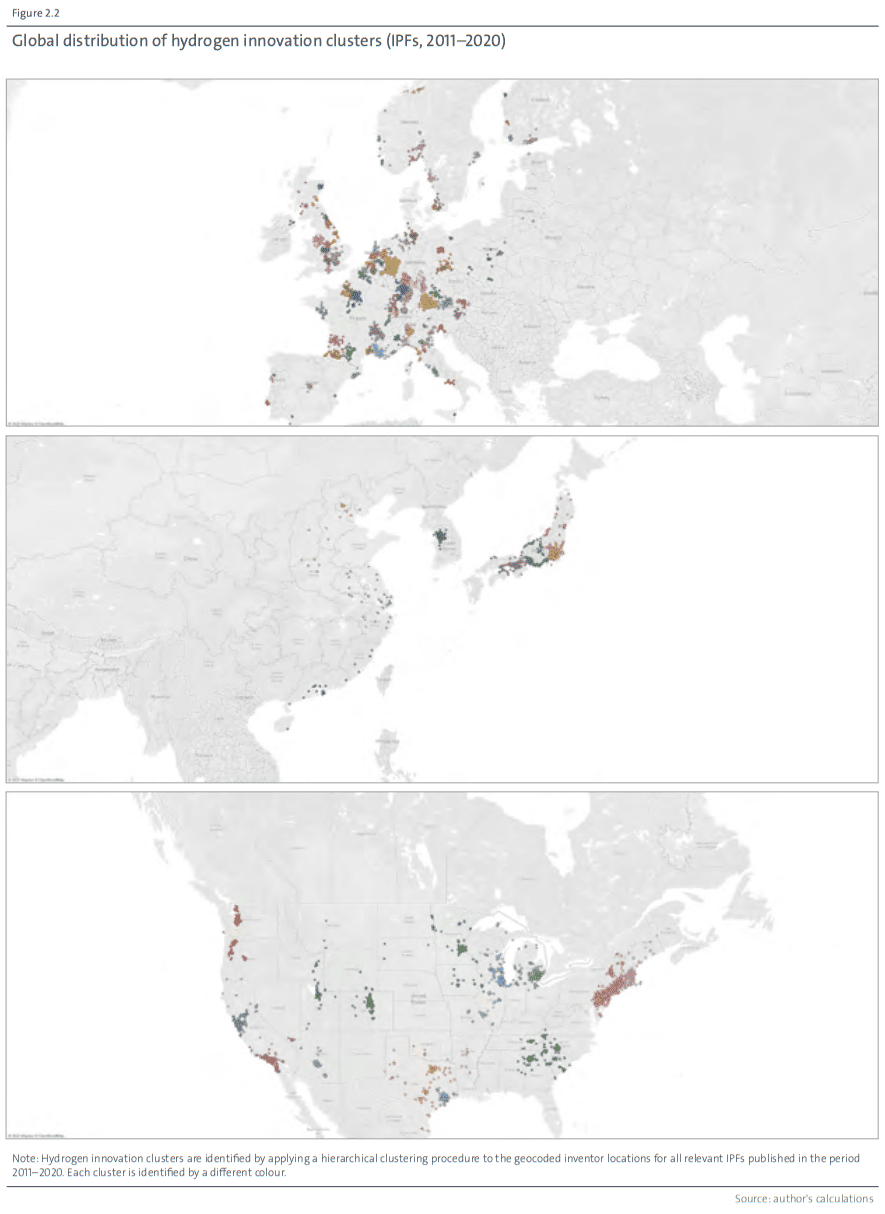
However, on another related report prepared for the G7 Climate, Energy and Environmental Ministerial meeting in April 2023 the IEA noted that the construction and commissioning of energy projects to produce Low-emission Hydrogen are stagnated “Most large-scale projects for the production of low-emission hydrogen are facing important bottlenecks. Only 4% of projects that have been thus far announced are under construction or have taken a final investment decision. Uncertainty about future demand, the lack of infrastructure available to deliver hydrogen to end users and the lack of clarity in regulatory frameworks and certification schemes are preventing project developers from taking firm decisions on investment.” 4
Hydrogen itself is a complex element that we are just in the process of harness. We must consider that Hydrogen is also a highly flammable element, because of its lightness is subject to be dispersed upwards, it burns more easily than other fuels, and hydrogen flames are invisible, making difficult to notice where exactly the fire is located. Any incident caused by a leak that leads to a transformer explosion could result in a serious incident, with heavy consequences for the companies involved on the financial point of view, an imminent danger for the people on the site, probable damages to the environment and mostly secure investigations from authorities to check on compliance of all regulations.
Specially within the Europe region there are very strict directives on the handling of hazardous elements like hydrogen and duties that go far beyond the regular duties and obligations that energy actors face in other territories.
The Seveso III 2012/18/EU Directive rules this subject from multiple points of view, imposing additional duties, charges, and obligations to anyone who want to be involved in the development of facilities that produce, treat, storage or transport Hydrogen. Its goal is to prevent major industrial accidents involving hazardous substances and limit the concentrations of those accidents on lives and environment.
From its factual and legal bases of the directive Legislative Act, the European Parliament determined some key considerations and guidelines. In the body of the legislation the EU statute the subject, definitions, general obligations, notifications dues to local authorities, the implementation of a major accident prevention policy, a safety report, duties for modifications of installations, emergency plans, actions to be taken in case of accidents, reports, and penalties to be applied in case of infringement.
We have prepared graphics to illustrate in an easy comprehensive manner all information to better understand this important regulation.
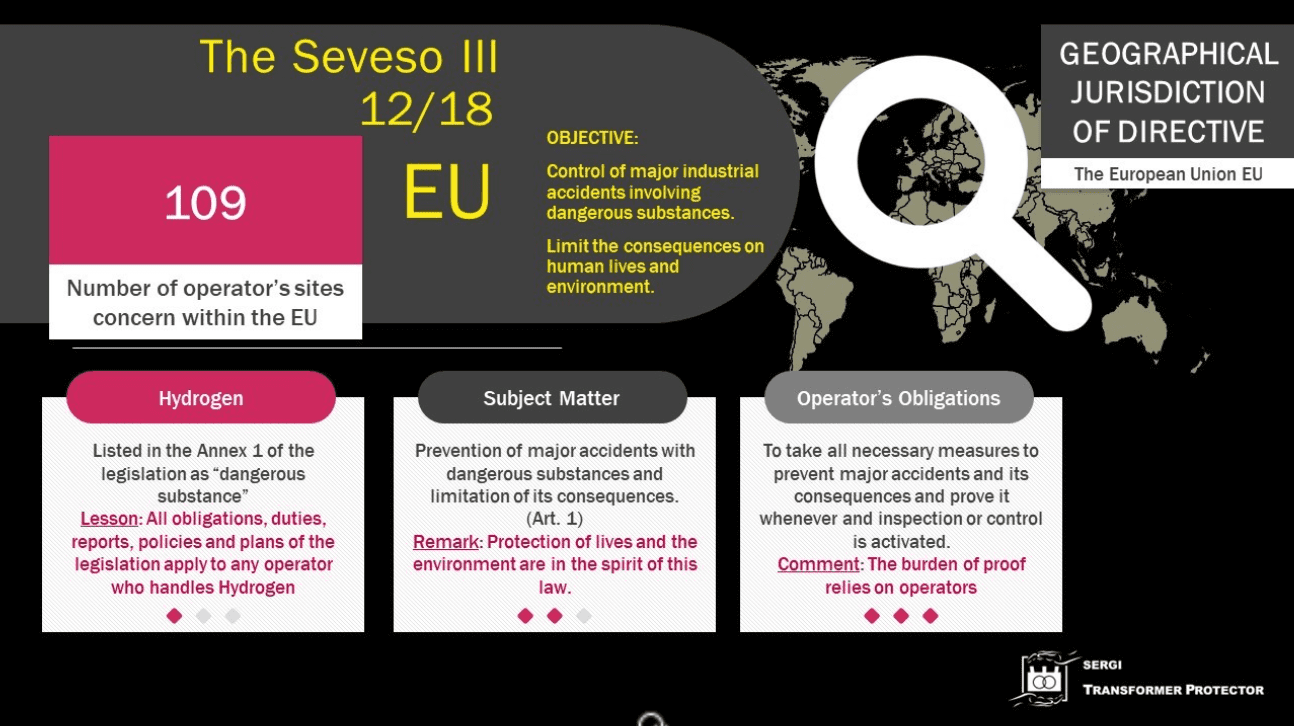
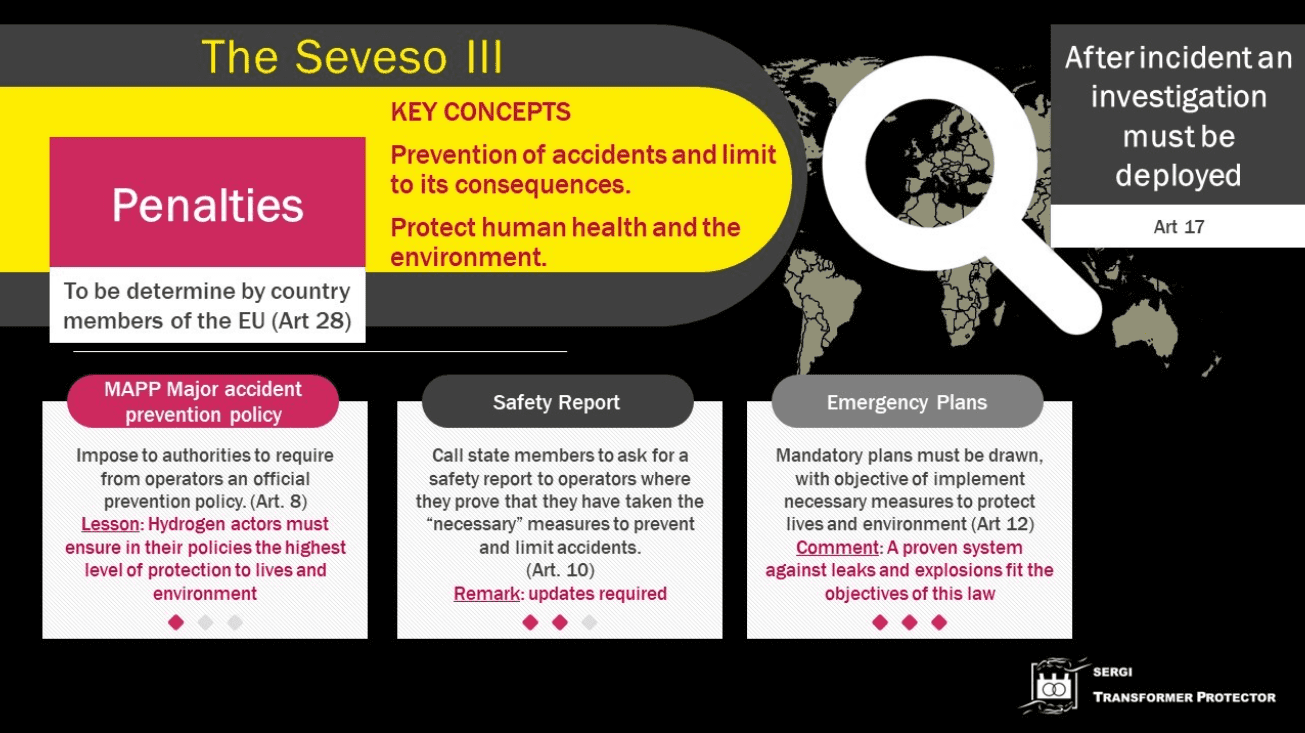
As shown, these regulations impose a series of duties and measures on actors to implement in their plans, from planning and construction to operation throughout the entire lifespan of their facilities. While the legislation is clear about the fact that operators must take every possible measure to prevent accidents involving hazardous materials and minimize their consequences, especially to protect lives and the environment, the law does not specify the tools that could help facilities’ operators achieve this goal.
In this context, tools like the TRANSFORMER PROTECTOR™ (TP) can assist actors in meeting the high safety and prevention standards required by this EU directive. From the project phase onward, the inclusion of TP can secure the entire fleet of transformers where it is implemented. It effectively shields the transformers, preventing explosions and subsequent fires. This solution has been rigorously tested by Test Laboratories of MEDEF and EDF and is recognized within the European Union as a proven method to prevent explosions in transformers due to low impedance failures.
The system, designed, manufactured, and installed by SERGI Transformer Protector, is intended to fortify electrical installations and effectively protect against and prevent transformer explosions and the subsequent fires caused by such explosions. As a fast depressurization system, it isolates the oil when accidents occur, preventing leaks and spills on the ground and in water sources, thereby safeguarding the environment.
It’s important to highlight that SERGI is a part of the ‘Task Force Hydrogène by MEDEF & France Hydrogène,’ which provides collective support to companies in the hydrogen sector and assists them in various phases of hydrogen-related projects.
In conclusion, Low-Emission Hydrogen stands as a pivotal force in the journey towards zero emissions, particularly favoring Green Hydrogen produced through clean energy sources such as solar and wind. Recent breakthroughs, like the flight by Stuttgart H2FLY using liquid hydrogen, emphasize a paradigm shift toward emissions-free aviation. Europe leads in innovative hydrogen technologies, as reflected in robust patenting activities. However, the construction of large-scale low-emission hydrogen projects faces critical bottlenecks, as highlighted by the IEA, necessitating regulatory clarity and infrastructure development.
The complexity and potential hazards of hydrogen underscore the crucial role of adhering to stringent safety regulations, exemplified by the Seveso III Directive in Europe. Compliance, supported by solutions like the TRANSFORMER PROTECTOR™, ensures not only operational safety but also environmental preservation in this dynamic hydrogen landscape.

